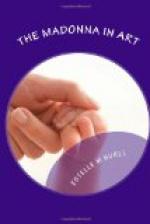The story of the friendship between these two men is full of interest. At the time of Raphael’s first appearance in Florence (1504), Bartolommeo had been four years a monk, and had laid aside, apparently forever, the brush he had previously wielded with such promise. The young stranger sought the Frate in his cell at San Marco, and soon found the way to his heart. Stimulated by this new friendship, Bartolommeo roused himself from lethargy and resumed the practice of art with increasing success. It is pleasant to trace the influence which the two artists exerted upon each other. The older man had experience and learning; the younger had enthusiasm and genius. Now it happened that, by nature, Bartolommeo was specially gifted in the arrangement of large compositions, with many figures and stately architectural backgrounds. It is by these that he is chiefly known to-day. So it is the more interesting that, when Raphael’s sweet simplicity first touched him, he turned aside, for the time, from these elaborate plans and gave himself to the portrayal of the Madonna in that simplest possible way, the half-length portrait picture. Several of these he painted upon the walls of his own convent, glorifying that dim place of prayer and fasting with visions of radiant and happy motherhood. One of these may still be seen in the cell sometimes called the Capella Giovanato. It instantly recalls the Tempi Madonna of Raphael, both in the pose of the figure and in the genuineness of feeling exhibited. Damp and decay have warred in vain against it, and the modern visitor lingers before the Mother and Babe with hushed admiration.
Two other similar frescoes have been removed to the Academy. They show the same motherly tenderness, the same innocent and beautiful babyhood. The mother holds her child close in her arms, pressing her forehead to his, or bending her cheek to receive his kiss. He throws his little arm about her neck, clinging to her veil or caressing her face.
Besides this group of pictures by Bartolommeo, there are other scattered instances of portrait Madonnas during the Italian Renaissance, by men too great to be tied to the fashions of their day. Mantegna was such a painter, and Luini another. All told, however, their pictures of this sort make up a class too rare to deserve longer description.
A century later, the Spanish school occasionally reverted to the same style of treatment. A pair of notable pictures are the Madonna of Bethlehem, by Alonzo Cano, and the Madonna of the Napkin, by Murillo. Both are in Seville, the latter in the museum, the former still hanging in its original place in the cathedral.
Of Cano’s work, a great authority[1] on Spanish art has written, that, “in serene, celestial beauty, it is excelled by no image of the blessed Mary ever devised in Spain.” Murillo’s picture is better known, and has a curious interest from its history. The cook in the Capuchin monastery, where the artist had been painting, begged a picture as a parting gift. No canvas being at hand, a napkin was offered instead, on which the master painted a Madonna, unexcelled among his works in brilliancy of color.




